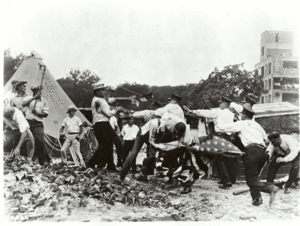The Bonus Army was the popular name of an assemblage of some 43,000 marchers—including 17,000 World War I veterans, their families, and affiliated groups—who gathered in Washington, D.C., in the spring and summer of 1932 to demand immediate cash-payment redemption of their service certificates. Led by Walter W. Waters, a former Army sergeant, the organizers referred to it as the Bonus Expeditionary Force to echo the name of World War I's American Expeditionary Force, while the media called it the Bonus March.
Many of the war veterans had been out of work since the beginning of the Great Depression. The World War Adjusted Compensation Act of 1924 had awarded them bonuses in the form of certificates they could not redeem until 1945. Each service certificate, issued to a qualified veteran soldier, bore a face value equal to the soldier's promised payment plus compound interest. The principal demand of the Bonus Army was the immediate cash payment of their certificates.
Although there was Congressional support for the immediate redemption of the military service certificates, President Hoover and Republican congressmen opposed such action. They reasoned that the government would have to increase taxes to cover the costs of the payout, and thus any potential recovery would be slowed.
The Veterans of Foreign Wars pressed the federal government to allow the early redemption of military service certificates. In January 1932, a march of 25,000 unemployed Pennsylvanians, dubbed "Cox's Army," had marched on Washington, D.C, the largest demonstration to date in the nation's capital, setting a precedent for future marches by the unemployed. On June 15, the House of Representatives passed the Wright Patman Bonus Bill, which would have moved forward the date for World War I veterans to receive their cash bonus, however, the Senate defeated the Bill.
Most of the Bonus Army camped in a Hooverville on the Anacostia Flats, a swampy, muddy area across the Anacostia River from the federal core of Washington D.C. The camps, built from materials scavenged from a nearby rubbish dump, were tightly controlled by the veterans who laid out streets, built sanitation facilities, and held daily parades. To live in the camps, veterans were required to register and prove they had been honorably discharged. Retired Marine Corps Major General Smedley Butler, one of the most popular military figures of the time, visited the Bonus Army's camp to back the effort and encourage them.
On July 28, U.S. Attorney General William D. Mitchell ordered the veterans to be removed from all government property. Washington police met with resistance, shots were fired, and two veterans were wounded and later died. Veterans were also shot dead at other locations during the demonstration . President Herbert Hoover then ordered the army to clear the veterans' campsite. Army Chief of Staff, General Douglas MacArthur, commanded the infantry and cavalry supported by six tanks. The Bonus Army marchers, with their wives and children, were driven out, and their shelters and belongings burned.

Bonus Army Conflict
Bonus Army marchers (left) confront the police.
The Bonus Army incident proved disastrous for Hoover's chances at re-election. He lost the 1932 election in a landslide to Franklin D. Roosevelt. A second, smaller Bonus March in 1933 at the start of the Roosevelt Administration, was defused in May with an offer of jobs for the Civilian Conservation Corps at Fort Hunt, Virginia, which most of the group accepted. Those who chose not to work for the CCC by the May 22 deadline were given transportation home. In 1936, Congress overrode President Franklin D. Roosevelt's veto and paid the veterans their bonus years early.